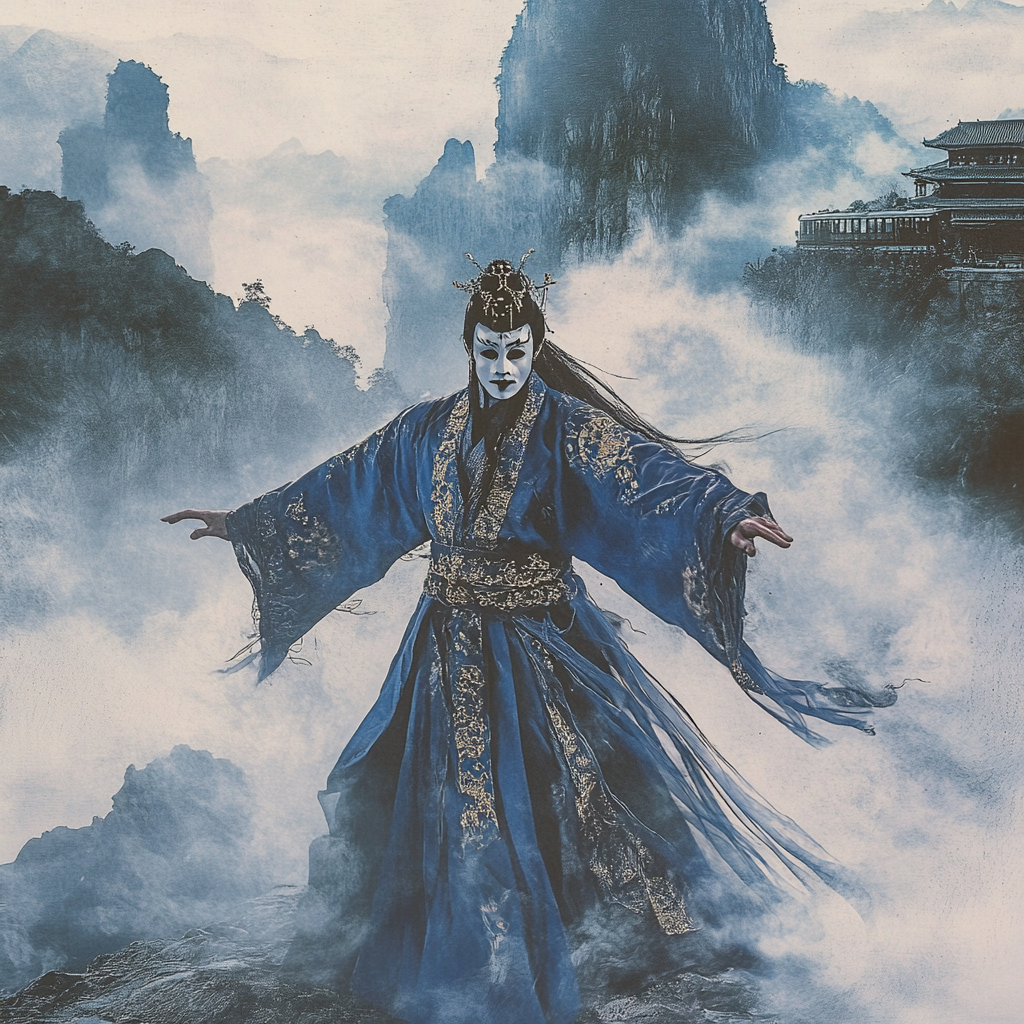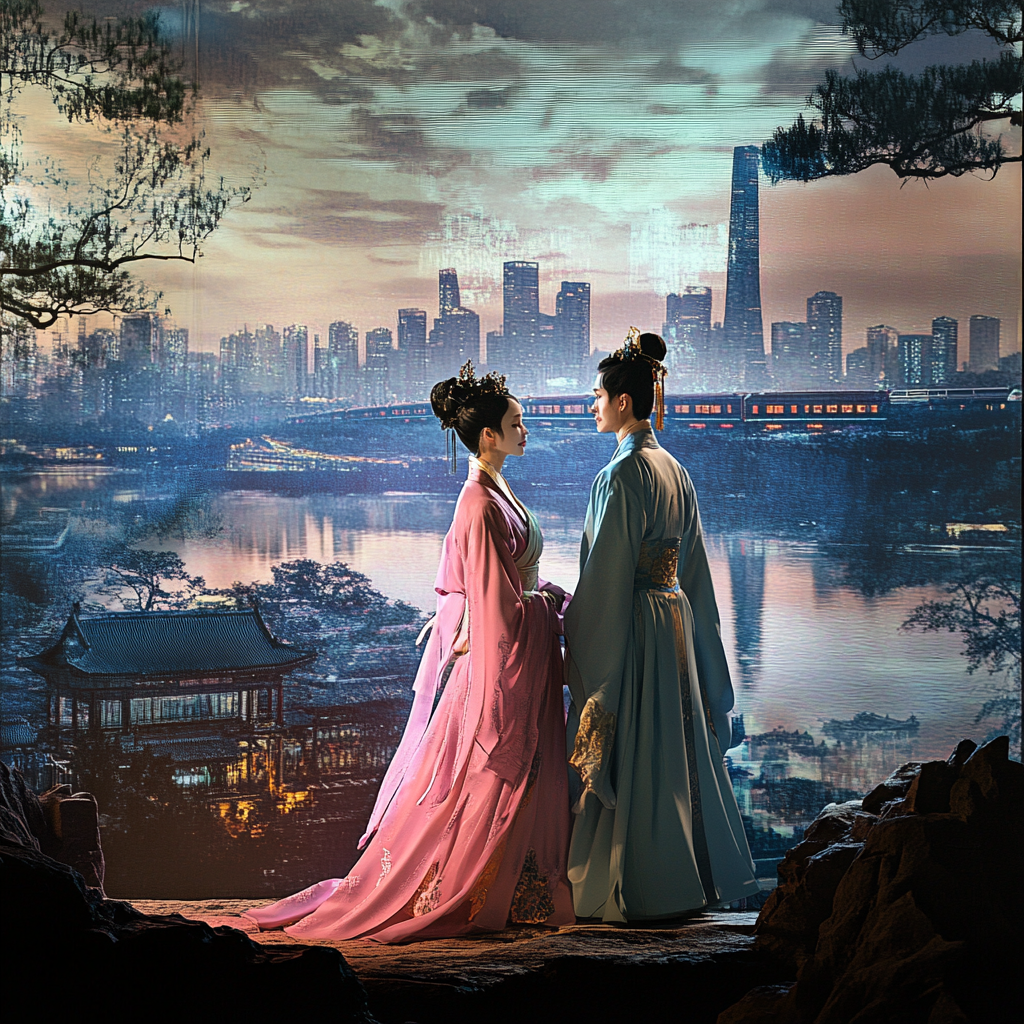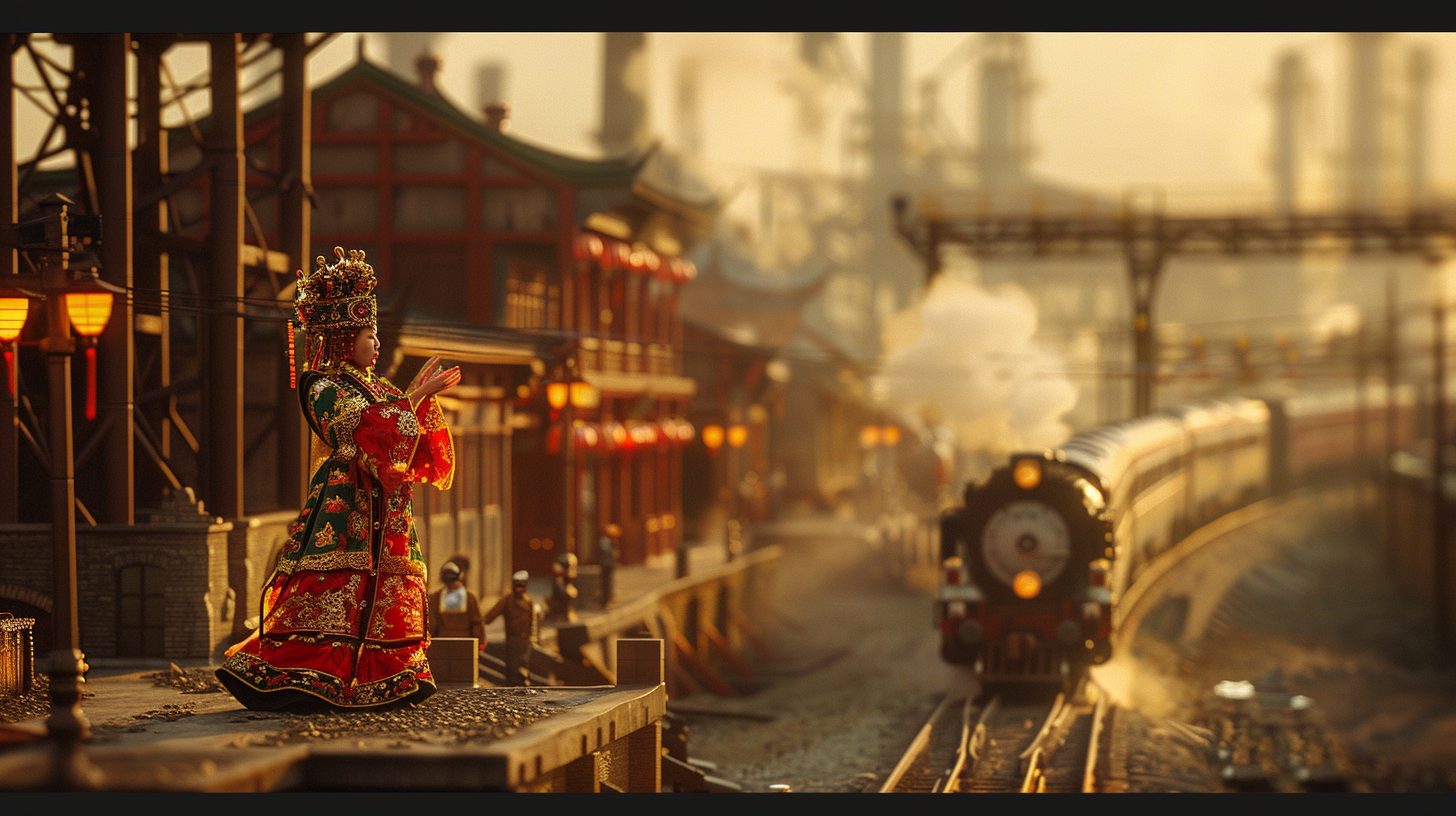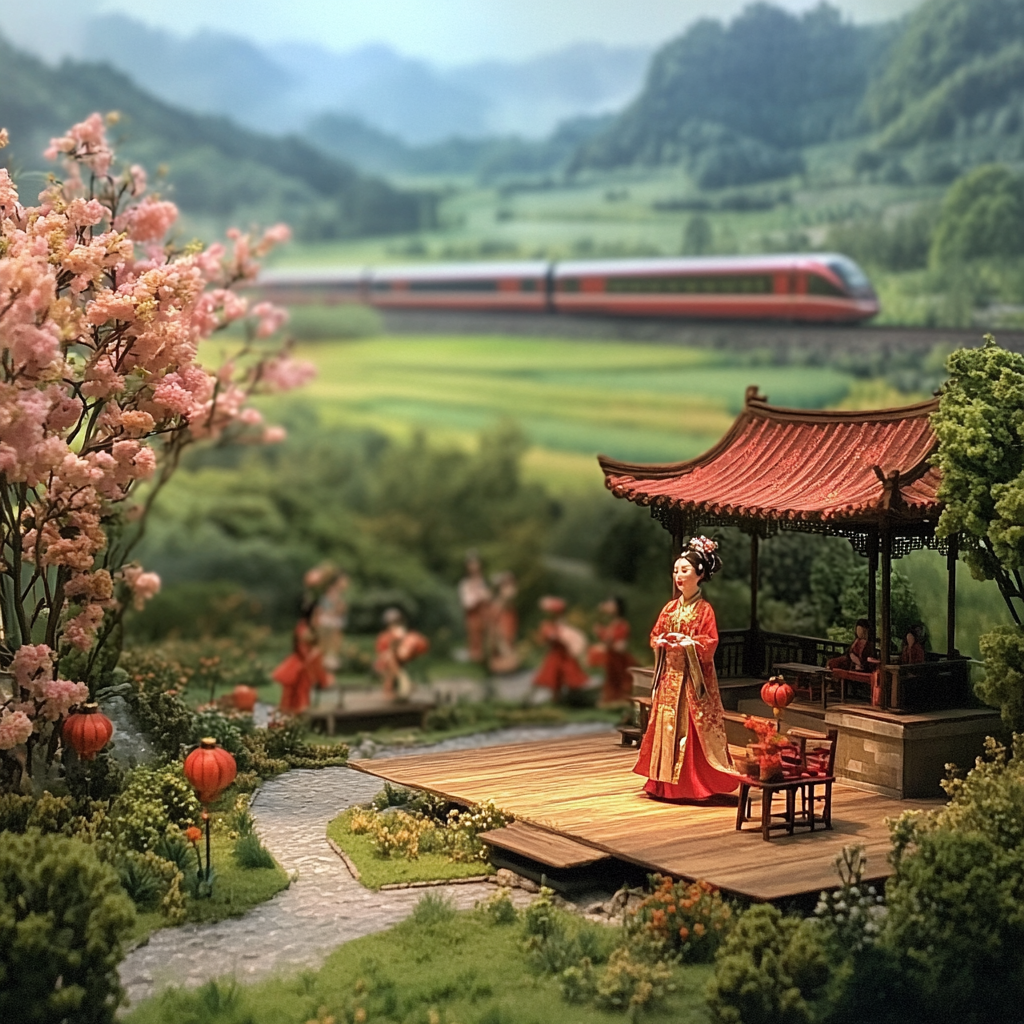戲曲,是中國人的聲音地圖;而高鐵,則是這個時代的速度軌跡。
一者訴說歷史與人情的緩慢藝術,一者承載科技與未來的迅疾脈搏。看似對立,實則交織。
我想用「中國高鐵戲曲地圖」,將這兩條看似平行的線縫合在一起——
讓中國傳統戲曲的唱腔在高鐵的時速中回響,讓梨園舊夢登上復興號的車廂。
當一地一劇種隨車站展開,當一聲鄉音在疾馳之中被重新記起,我們或許能在奔波之餘,重新凝視那個來自文化深處的問題:
走得再快的時代,能否留得住一個唱得很慢的靈魂?
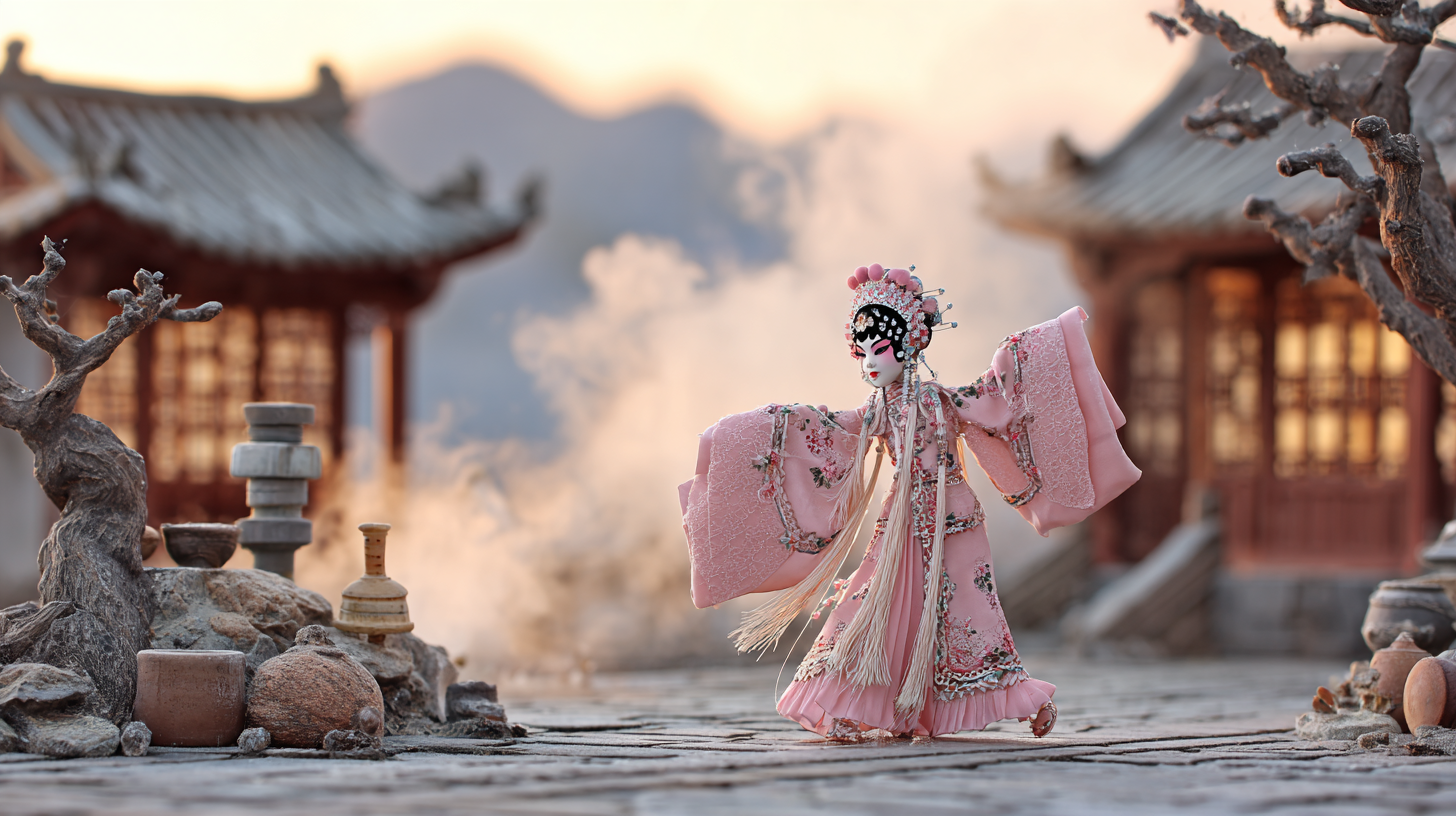
这篇文章以“节奏文明观”为线索,探索三种看似迥异却内在共鸣的文化结构:梨园戏的“十八步科母”、高铁动车的“车头塑形程式”与AI教育中的“身体感知教学法”。梨园戏以一整套步伐、身段、手势与呼吸的结构谱出身体写就的戏剧语言;动车车头以毫米为单位的工艺弧线回应速度、风阻与视觉美学的三重需求;而教学现场,则在寻找一种新的节奏方法,使知识传递能触及呼吸与共情。三者皆不是“起点”的象征,而是文明节奏系统中可感、可续、可传的“结构之美”。从戏台到车头,从课堂到身法——节奏不止于动静之间,它是一种通往文化深处的方式,也是一种我们今日仍在书写的文明共鸣。Guided by the lens of “Rhythm Civilization,” this essay explores three cultural structures that appear distinct yet resonate within: the Liyuanxi opera’s “Eighteen Mother Steps,” the aerodynamic “nose-cone shaping grammar” of China’s EMU trains, and an AI-era pedagogy of “embodied sensing.”
Liyuanxi composes a theater of the body—an integrated score of steps, stances, gestures, and breath that writes drama in movement. The train’s headform, engineered to the millimeter, answers the triad of speed, drag, and visual aesthetics with a precise craft arc. And in the classroom, we search for a new rhythmic method by which knowledge transfer can reach breath and empathy.
None of the three stands merely as a “beginning”; each embodies a beautiful structure within a civilizational rhythm system—perceptible, sustainable, and transmissible. From stage to nose-cone, from classroom to body method, rhythm does not end with motion and stillness. It is a path into the depths of culture—and a resonance of civilization we continue to write today.
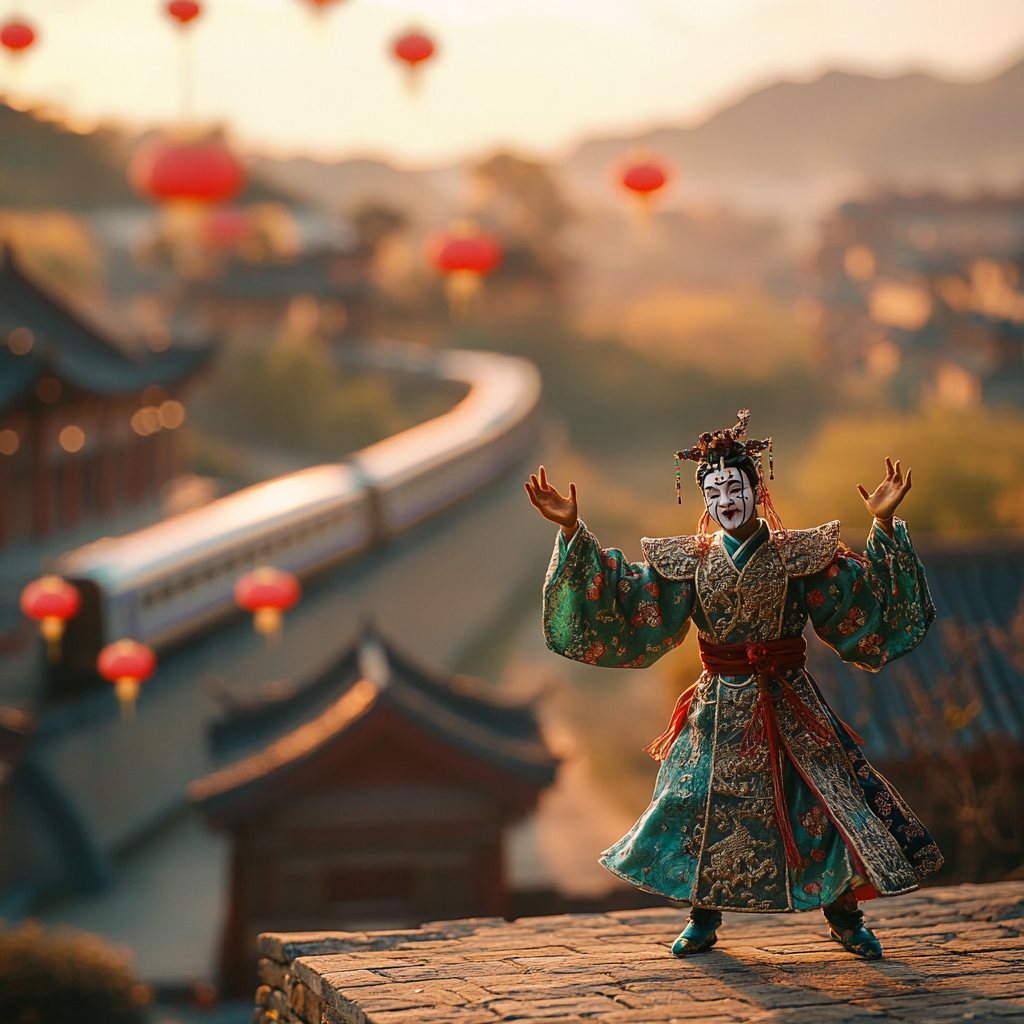
這不是一篇地方戲曲的導覽文,而是一場關於「吼」的文明對話。本文以「節奏文明敘事法」書寫,將秦腔、高鐵與教育視為三種節奏系統:身體的吶喊、技術的轟鳴、認知的節拍。從秦腔的「吼」談起,深入探討其聲腔結構與文化根性,再寫至「噴火」這一絕技,呈現其從儀式邊界到劇場張力的轉化。文章亦以「跳躍、旋轉、流轉」三節奏為軸,連結高鐵的節拍設計、教育的節奏翻譯,與秦腔的身體動作與情緒流動。西成高鐵穿越秦嶺,百年易俗社守望西安,鐵道、舞台與教室,在此三重共鳴中形成一首文明的吼唱。這不是文化的追憶,而是一場面向未來的節奏再啟。This is not a guide to local opera, but a civilizational dialogue about the roar. Written in the narrative key of Rhythm Civilization, it treats Qinqiang opera, high-speed rail, and education as three rhythm systems: the body’s outcry, technology’s thunder, and cognition’s beat. Beginning with Qinqiang’s hou—its roar—we delve into its vocal architecture and cultural roots, then to the virtuoso feat of “spitting fire,” tracing its shift from ritual boundary to theatrical tension.
Guided by the triplet leap · turn · flow, the essay links rail tempo design and pedagogical rhythm to Qinqiang’s corporeal gestures and emotional currents. As the Xi’an–Chengdu HSR cleaves the Qinling Mountains and the century-old Yisu Society keeps watch over Xi’an, track, stage, and classroom rise in triple resonance—forming a choral roar of civilization. This is not a backward glance at culture, but a rhythm reboot aimed at the future.
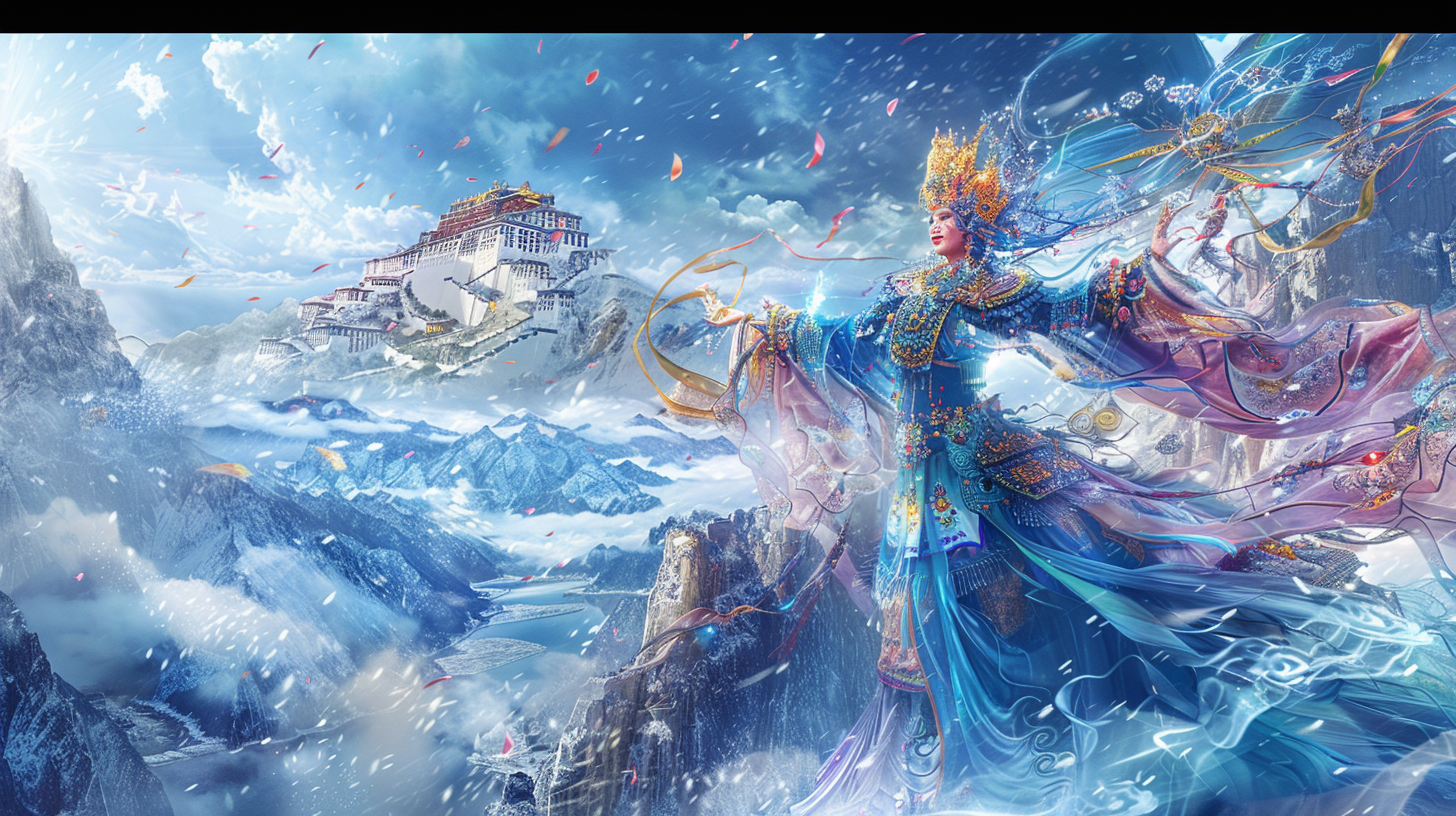
这是一篇关于节奏的文章,也是一场跨越山河与时代的三重奏。藏戏,以慢为信,以面具为门,一步一顿地唤醒六百年的轮回记忆;拉林高铁,穿越雪域高原,不争速度而守稳重,在技术与生态之间练习“缓行的哲学”;而云端之上的教育,则在算法与智能之间,重新思考“灵魂何时到场”。我们不以“快”或“慢”二元对立,而以“节奏文明叙事法”书写:跳跃,是意识的跃迁;旋转,是身体与记忆的交织;流转,是文明在未来中继续回响。《轮回之戏》,既是藏戏的哲学,也是高铁与教育在新时代节奏中的一次集体沉思。面具之后,是人;速度之间,是理解。在高原之上,我们聆听时间的另一种走法。This is an essay about rhythm—and a triple concerto that crosses mountains, rivers, and eras. Tibetan opera takes slowness as its creed and the mask as its portal, waking six centuries of cyclical memory step by measured step. The Lhasa–Nyingchi railway traverses the snowbound plateau, not chasing speed but holding steady—practicing a “philosophy of slow travel” between technology and ecology. And education on the cloud rethinks, between algorithm and intelligence, the question of when the soul arrives.
We refuse the fast/slow binary and write instead in the narrative of Rhythm Civilization: leap as a shift of consciousness; turn as the weaving of body and memory; flow as civilization’s echo continuing into the future. The Theater of Rebirth is at once the philosophy of Tibetan opera and a collective meditation on the tempos of a new age for rail and learning.
Behind the mask, a person. Between velocities, understanding. Upon the high plateau, we listen for another way time can move.
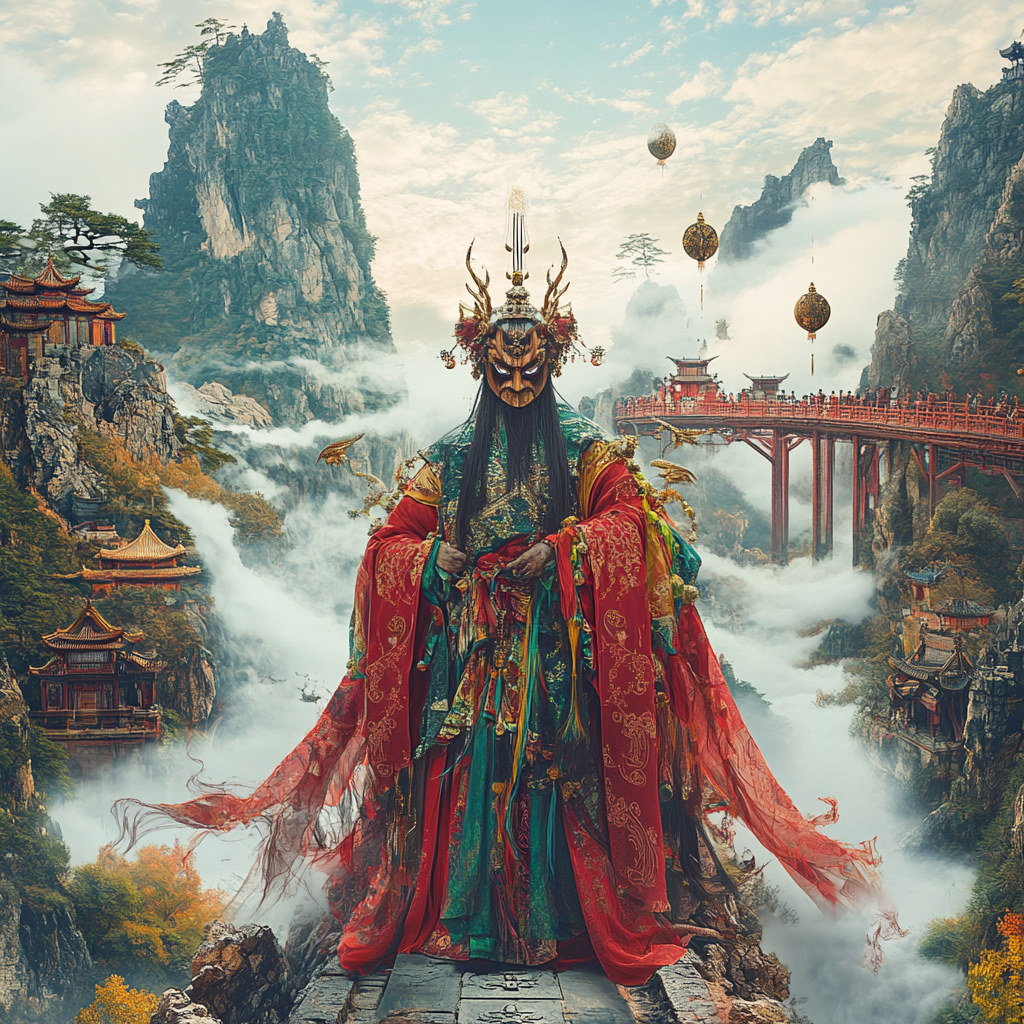
在貴州銅仁德江的山中,有一場戲,不為娛樂,也不為觀眾——它為神而演,為祖先而舞。它叫儺戲,是中國戲劇的原始形態,是用面具與身體寫下的祈禱文本。與此同時,滬昆高鐵以每小時350公里的速度跨越山河,將這片「節奏緩慢」的土地納入時代的疾馳之中。本篇博客《靈面千秋》,試圖讓古老與當代在「節奏」中對話:儺戲的跺步與高鐵的鋼軌,AI教室與神明的低語,是否能共鳴出文明新的心跳?我們從儺面說起,談到高鐵穿境,再走向AI時代的教育試驗,用詩意文本、文化觀察與技術反思,共同編織一幅「速度與信仰」的感知地圖。這不僅是一次文化敘事的嘗試,更是一場節奏文明觀的實踐演習。慢下來,或許你也能聽見,那些不是演給人看的戲,正從山裡走來。In the mountains of Dejiang, Tongren, Guizhou, there is a drama performed neither for entertainment nor for an audience—it is acted for the gods and danced for the ancestors. It is called nuo opera, the primordial form of Chinese theater, a prayer text written in masks and bodies.
Meanwhile, the Shanghai–Kunming high-speed rail crosses ranges at 350 km/h, drawing this “slow-tempo” land into the rush of the age. Spirit-Faced Through the Ages seeks a dialogue of “rhythm” between ancient and contemporary: can the stomping steps of nuo and the steel cadence of HSR, the whispers of deities and the AI classroom, resonate into a new heartbeat of civilization?
We begin with the nuo mask, speak of the railway passing through, then move toward experiments in education for the AI era—interweaving poetic prose, cultural observation, and technological reflection to map a sensorium of “speed and faith.” This is not only an attempt at cultural narration, but a field exercise in the view of Rhythm Civilization. Slow down, and perhaps you too will hear those plays not meant for human eyes, making their way out of the mountains.
《一脸三绝》沿沪渝蓉高铁进入巴蜀,以川剧“变脸、吐火、滚灯”三绝为线索,对望重庆与成都的山河与市井;在速度与戏曲之间,寻找文明的节奏与呼吸,记录一次以AI协作为支点的当代文化观察与实践。“Face of Three Marvels” follows the Shanghai–Chongqing–Chengdu HSR, tracing Sichuan Opera’s face-changing, fire-spitting and rolling-lamps to mirror Chongqing & Chengdu, seeking a civilizational rhythm through speed, stage and AI-assisted inquiry.
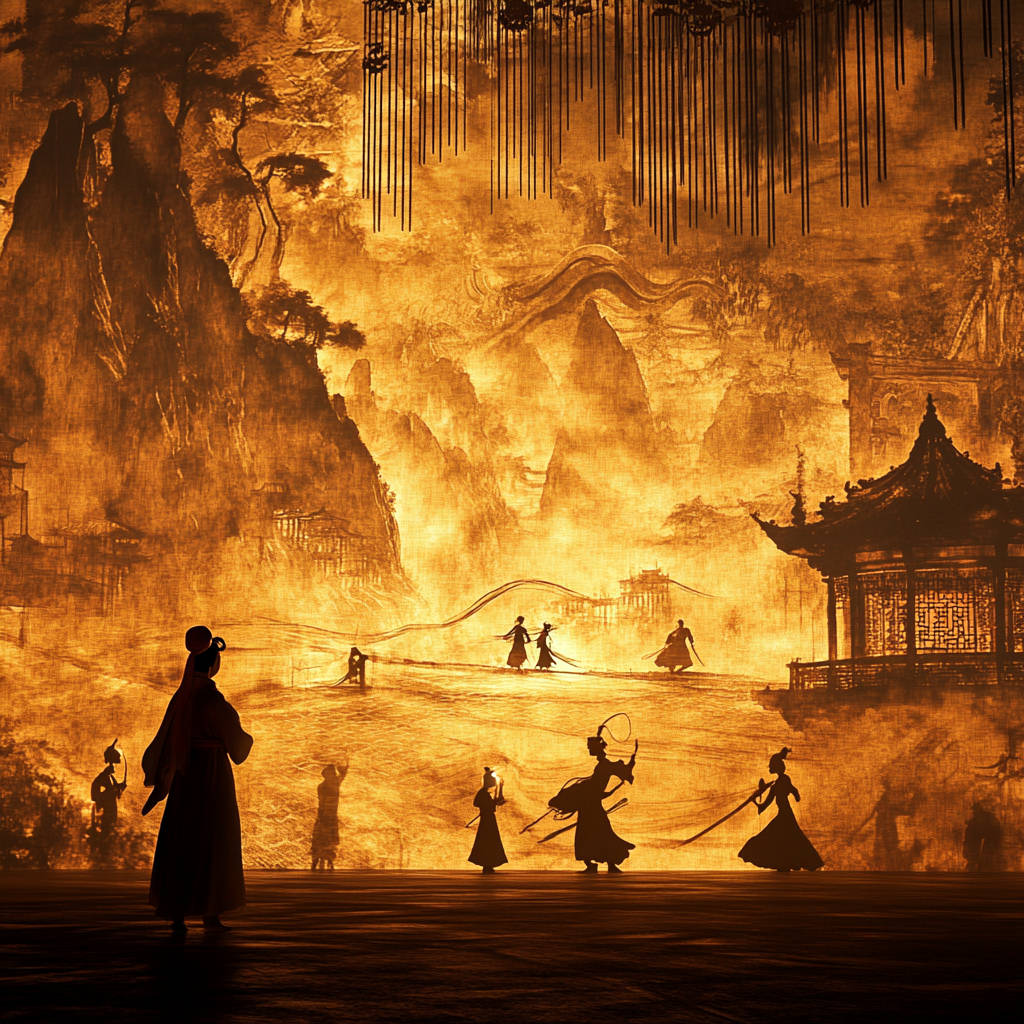
从一束白幕下的灯火,到一列飞驰而过的高铁,皮影戏与郑西高速铁路在时空中交汇,并非巧合,而是文明深处的回响。它们,一个缓缓铺展于掌中,一张皮、一口唱,讲述着千年忠义与悲欢;一个呼啸掠过秦晋之地,载着当代的生活节奏与梦想归途。而郑西高铁,在疾驰之间不忘凝视,让纸上的剪影与时代的列车同行。在这光与轨道之间,我们不仅看见传统在被唤醒,也看见教育与文化,正在以更自由、更丰富的方式回到我们的生活与孩子的心中。这是一次文明节奏的重组:有缓有急,有古有新。皮影不再是乡间庙会的余响,而成为数字剧场、AI课堂与少年记忆里的温柔火光。文化,从未走远;只是换了一种速度,继续抵达。From a beam of lamplight beneath a white screen to a bullet train flashing past, shadow puppetry and the Zhengzhou–Xi’an high-speed railway meet across time and space—not by chance, but as an echo from the depths of civilization.
One unfolds slowly in the palm—a sheet of hide, a single singing voice—telling millennia of loyalty and of joy and sorrow. The other whistles across the lands of Qin and Jin, carrying today’s rhythms of life and the homebound dreams of its passengers. And the Zhengzhou–Xi’an line, even in its haste, does not forget to gaze—to let the cutout figures on paper travel alongside the train of an era.
Between light and rail we see not only tradition awakened, but education and culture returning to our lives and to our children’s hearts in freer, richer forms. This is a reassembly of civilizational rhythm: now slow, now swift; now ancient, now new. Shadow play is no longer merely the fading echo of village temple fairs; it has become the gentle flame within digital theaters, AI classrooms, and youthful memory. Culture has never gone far—it has simply changed speed, and keeps arriving.
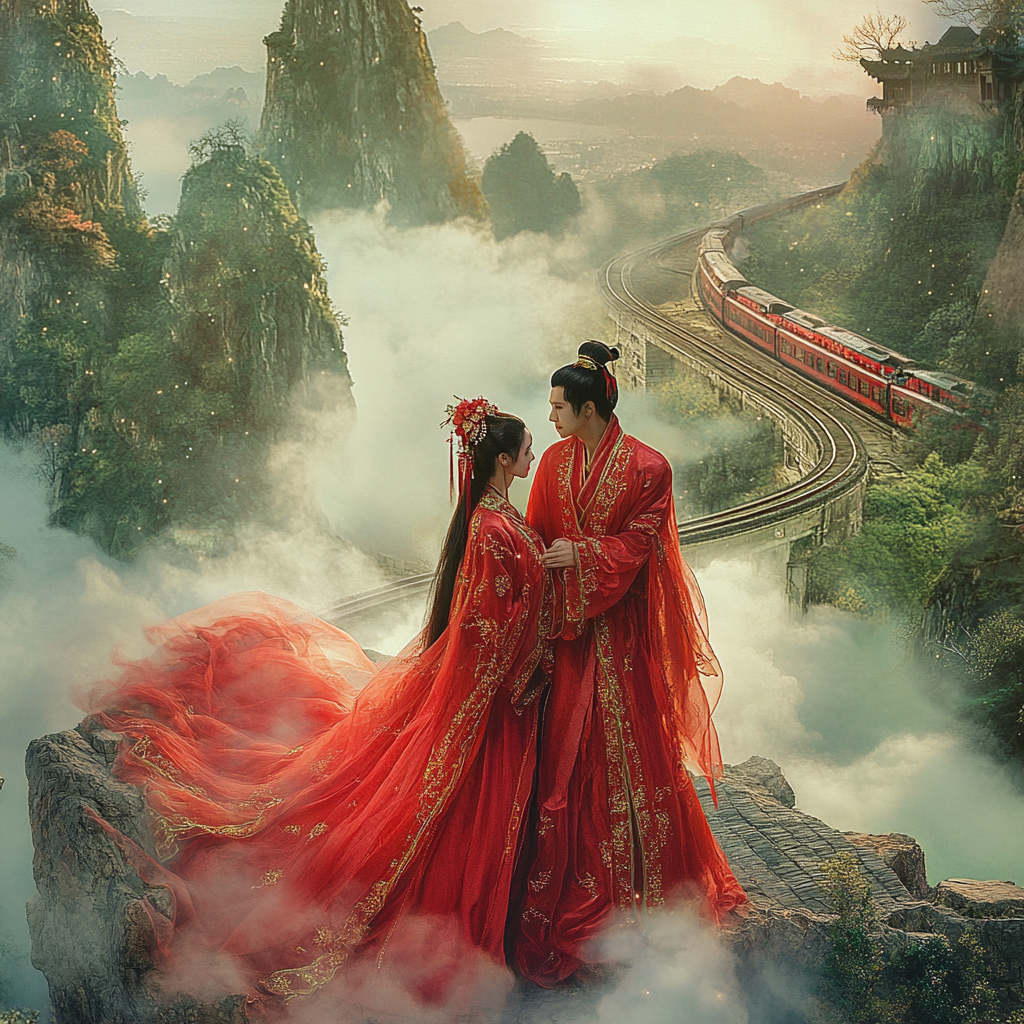
这是一趟从申城舞台到剡溪水畔的文化穿越,也是一曲由越剧、铁路与时代共同谱写的温柔合唱。《越音未央》以青春越剧《我的大观园》为引,以沪昆与杭台两条高铁为线,勾勒出一幅“流动的江南抒情”。文章回望越剧百年,从“草台男班”到“数字剧场”,从《新龙门客栈》的沉浸快意到《我的大观园》的梦境流转,它讲述的不只是戏剧的变与不变,更是一个剧种与时代并肩前行的生命力。借由高铁这条现代动脉,越音不再局限于舞台之上,而是成为可被听见、被抵达、被传承的文化日常。在速度中呼应缓慢,于钢轨间守护柔声,越剧与高铁共同构建出当代中国文化最柔韧也最坚定的回响。This is a cultural crossing from the stages of Shanghai to the banks of the Shanxi River—also a gentle chorus composed by Yue opera, railways, and our times. Taking the youth production My Grand View Garden as its prelude, and tracing the Shanghai–Kunming and Hangzhou–Taizhou high-speed lines as its staff lines, Yue Echo, Unending sketches a “moving Jiangnan lyric.”
Looking back on a century of Yue opera—from “grass-stage male troupes” to “digital theaters,” from the immersive rush of New Dragon Gate Inn to the dreamlike currents of My Grand View Garden—the essay tells not only of what changes and what endures, but of a genre’s vitality as it walks shoulder to shoulder with its era. Through the modern artery of HSR, Yue opera is no longer confined to the stage; it becomes part of everyday culture—heard, reached, and passed on.
Answering slowness within speed, guarding a soft voice between steel rails, Yue opera and high-speed rail together form one of contemporary China’s most supple—and most steadfast—resonances.

當南廣高鐵與廣深港高鐵飛馳於嶺南大地,粵劇的悠悠腔韻悄然浮現於車窗之外。這篇文章從《帝女花·香夭》那句「落花滿天蔽月光」展開,以戲曲與鐵道的雙聲部對話,述說一條連接故鄉與遠方、速度與情感、現代與傳統的文化軌跡。粵劇不再局限於廟會戲臺,而是乘高鐵同行於萬里歸途。她是南國紅氍毹之魂,是廣府人鄉音未改的記憶之所;而高鐵,是現代中國的速度象徵,也是文化的載體與延伸。透過紅線女與紅虹的雙代記憶、佛山與廣州的命脈共振,本篇文字描繪出一幅既詩意又深情的中國戲曲與鐵道融合畫卷,訴說一場關於家、鄉愁與文化傳承的動人旅程。As the Nanning–Guangzhou and Guangzhou–Shenzhen–Hong Kong high-speed lines race across the Lingnan plain, the lingering melodies of Cantonese opera rise quietly beyond the window. Taking the line “Falling flowers veil the moonlit sky” from The Reincarnation of Fragrance (Di Nü Hua · Xiang Yao) as its point of departure, this essay stages a two-voiced dialogue between opera and railway—mapping a cultural trajectory that connects home and afar, speed and feeling, modernity and tradition.
Cantonese opera is no longer confined to temple fairs and makeshift stages; it rides the high-speed rails along the ten-thousand-li homeward route. It is the soul of the southern red felt stage, the place where Cantonese people keep their native tones unchanged; and high-speed rail is the emblem of contemporary China’s velocity—a carrier and extension of culture itself.
Through the paired memories of Hung Sin Nui and Hung Hong, and the pulsing resonance between Foshan and Guangzhou, this piece sketches a lyrical, heartfelt tableau where Chinese opera and railway converge—telling a moving journey of home, homesickness, and cultural transmission.
《水磨入夢》是一場崑曲與高鐵的文化對話,一次穿越江南水鄉的詩意旅程。當蘇杭城際高鐵飛馳而過,水磨腔緩緩響起,如舊夢回聲,在車窗之外與現代速度共鳴。蘇州的地理孕育了崑曲的婉轉聲腔,也承載了中國人對美、理想與自我追問的千年之夢。這不是一幅畫,而是一條仍在吟唱的時間之路。Water-Polished into a Dream is a cultural dialogue between Kunqu opera and high-speed rail—a poetic journey through the water towns of Jiangnan. As the Suzhou–Hangzhou intercity line races past, the soft, “water-polished” timbre of Kunqu rises, like the echo of an old dream, resonating with modern velocity beyond the window.
Suzhou’s geography nurtured Kunqu’s winding melodies and has borne, for a thousand years, the Chinese pursuit of beauty, ideal, and self-inquiry. This is not a painting, but a road of time that is still singing.
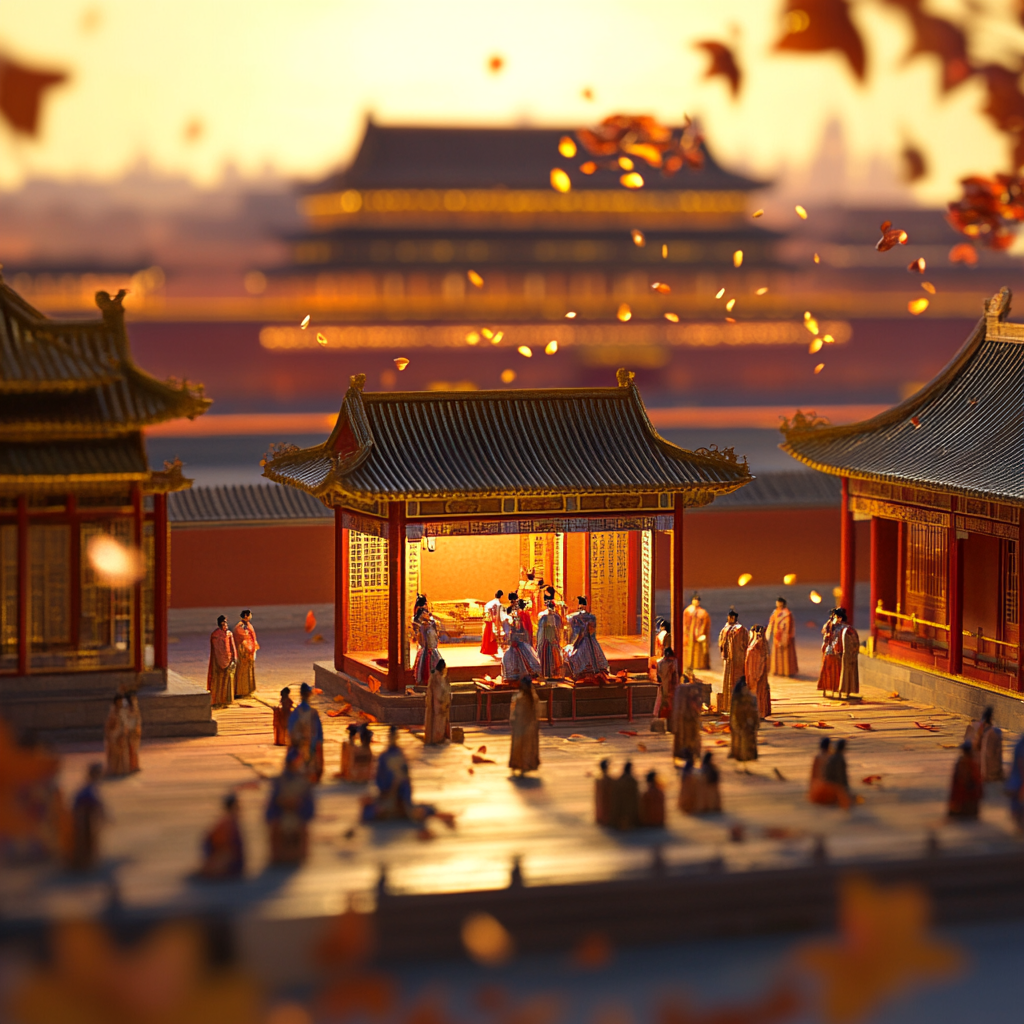
《梨园长路》是一篇穿越时空的文化随笔,沿着京港高铁自安徽安庆至北京的轨迹,回望京剧从徽班进京到登上世界舞台的百年征途。文章以诗意语言描绘唱腔与地理的联结、传统与现代的共鸣。梅兰芳以身化腔,成为一人承城的文化灯塔;而今日高铁,则像一曲流动的唱段,将千里梨园路压缩于瞬息。戏班早行,风声未绝,唱腔犹在。这不仅是京剧的回声,更是中华文化在速度时代中的一次温柔而坚定的延续。The Long Road of the Pear Garden is a cultural essay that travels across time and space, tracing the Beijing–Hong Kong high-speed rail from Anqing, Anhui to Beijing, and looking back on Peking Opera’s century-long journey—from Anhui troupes entering the capital to its rise on the world stage. In poetic language, it maps the bond between vocal style and geography, the resonance between tradition and modernity.
Mei Lanfang turned his very body into song, becoming a cultural lighthouse who bore a city upon his shoulders; today’s high-speed rail, like a flowing aria, compresses a thousand-li opera road into an instant. The troupe sets out at dawn, the wind not yet stilled, and the melody still in the air. This is not only the echo of Peking Opera, but a gentle, steadfast continuation of Chinese culture in an age of speed.
评剧,这门诞生于滦河岸边的北方唱调,从“莲花落”的地头乡音出发,借着成兆才之手成为国家剧种。唐山是她的摇篮,如今,她乘着京唐城际穿越时代的长廊,再次在人们心头唱响。这篇文章以诗意笔触串联起评剧的源流、唱腔、人物与城市,讲述一段跨越百年的文化回响。Pingju—a northern melody born on the banks of the Luan River—rose from the rustic lianhua-luo street ballads and, through Cheng Zhaocai’s hand, became a national opera form. Tangshan is its cradle; today, riding the Beijing–Tangshan intercity line, it travels the corridor of time to sing once more in people’s hearts.
This essay threads together, in a lyrical register, Pingju’s origins, vocal style, key figures, and the city that nurtured it—telling a century-spanning cultural echo.
黄梅戏,一种源于湖北山野的乡音,被安徽安庆锤炼成中国五大剧种。黄黄高铁自西而来,穿越黄梅东站,却略过了真正的县城与戏曲源头,仿佛命运里唱错的一笔。这一篇文章,追踪一段戏调的迁徙之旅:从采茶调的田间清唱,到安庆舞台上的百年大成,再到高铁时代的风声过耳与站名闪现。唱腔与车速交错,一声“黄梅”,跨越地理,也深植人心—这是高铁上的乡音地图,也是一段未曾停驻,却从未走远的文化回响。Huangmei opera—born as a rustic dialect of Hubei’s hills and honed in Anqing, Anhui into one of China’s five great operatic forms. The Huanggang–Huangmei high-speed line sweeps in from the west, passes through Huangmei East Station, yet skirts the true county seat and the art’s original wellspring—as if fate had sung a wrong note.
This essay traces the migration of a melody: from the fieldside cai-cha-diao tea-picking tunes, to a century of consummation on Anqing’s stages, and onward to an age when the wind of high-speed trains rushes past and station names flicker by. Vocal lines and train speed intersect; one cry of “Huangmei” crosses geography and takes root in the heart. It is a map of hometown sound drawn upon the rails—and a cultural echo that never made a full stop, yet has never gone far.





